Are your radiators looking a little rough? Or perhaps you just want to change the color? Either way, a fresh coat of paint will make all the difference. Whether your radiator is chipped, rusty, or just needs a little facelift, painting it is easier than you might think! In this post, you’ll find a step-by-step guide on how to paint a radiator, the different paint options, and a couple tips on how to handle rust!
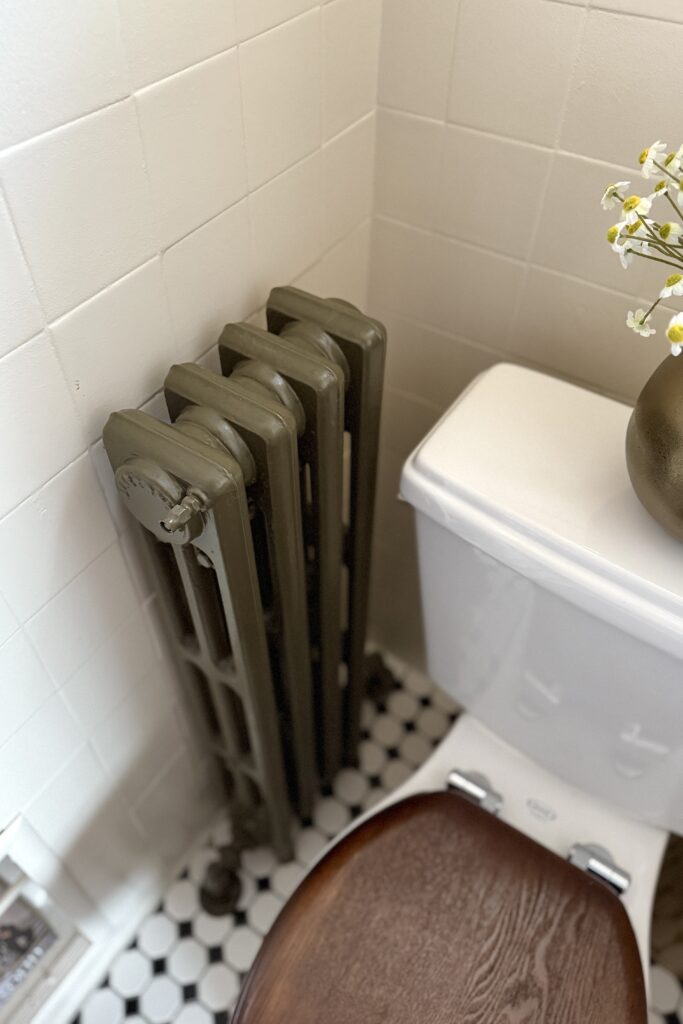
Disclaimer: This post contains affiliate links. This means, if you purchase something from a link I provided, I will receive a small commission. This is at no extra cost to you! Thank you so much for the support!
TOOLS:
- Lead Paint Test Kit
- Radiator Brush
- Wire Brush
- Paint Sprayer (Optional)
MATERIALS:
- Gloves
- Respirator
- Sandpaper
- Painter’s Tape
- Plastic Drop Cloths
- Primer
- Paint
Before You Begin…
The very first thing you’ll want to do is turn your radiator off and let it cool completely. This is also a perfect time to test your radiator for lead using a lead paint test kit! This is especially important to do before starting any sanding or scraping. If your radiator paint isn’t chipping or peeling, you don’t need worry too much.
If your paint does test positive for lead, and it’s peeling, you can either call a professional to safely remove it, or you can use an encapsulant primer to seal the lead before painting. Avoid any sanding or scraping!
Lastly, gather all your materials, including gloves, a mask, and safety glasses.
Step One: Clean the Radiator
If your radiators are anything like mine, they have a collection of dust. The first thing I did was vacuum what I could!
Grab a bucket of warm water and add some tsp powder to the water. This is optional, but tsp is a popular cleaner and degreaser used specifically for prepping surfaces for paint!
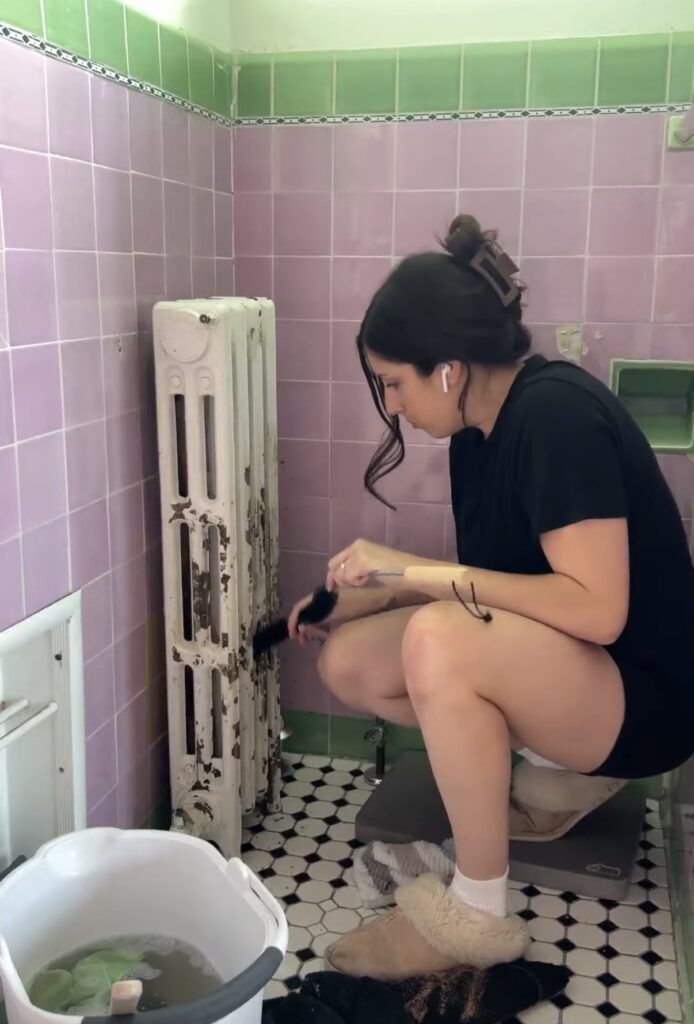
I used a combination of this radiator brush, this flexible bristle brush, and a microfiber cloth to clean our radiator. If you’ve ever tried to clean a radiator, you know how tricky it is getting into all the crevices, but these brushes are so helpful.
Let the radiator dry completely before moving on to the next step!

Step Two: Smooth the Surface
As a reminder, skip this step if you tested positive for lead paint!
If you have any loose paint, scrape that off first. I used a small chisel and a wire brush to get the chipping paint off of our old radiator. You don’t have to remove all the old paint, just focus on getting the pieces that are flaking off.
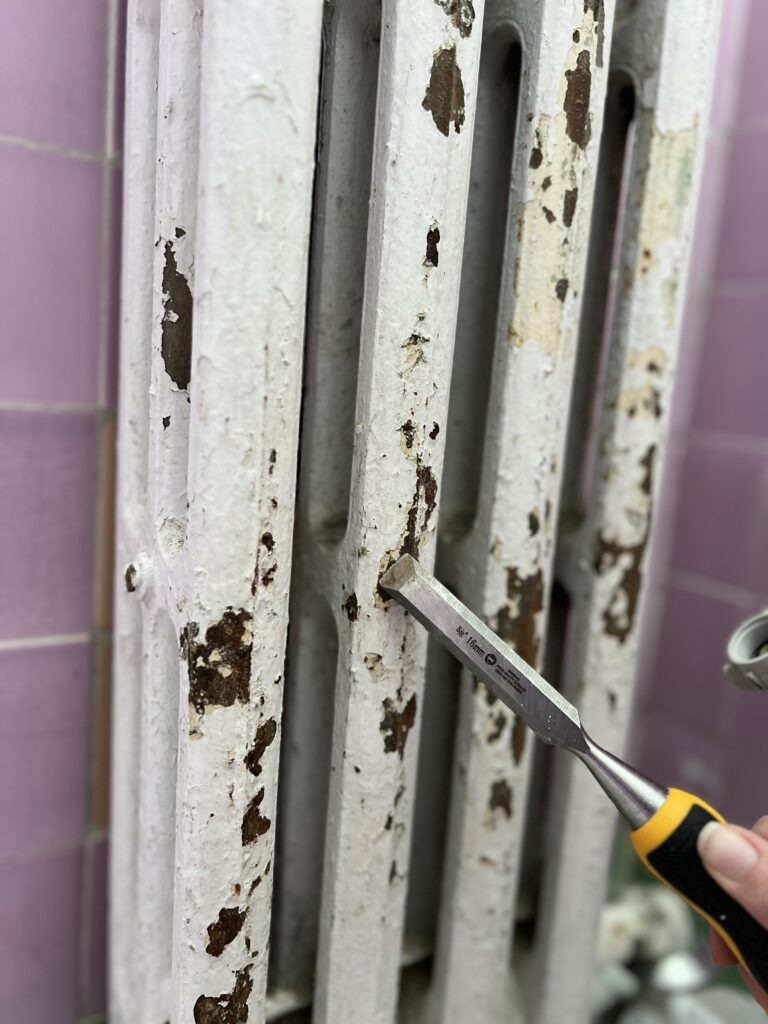
After this, I sanded the entire radiator with coarse-grit sandpaper. I got what I could with a sanding sponge, but in order to get some of the hard to reach areas I used this sanding drum attachment on my drill! If you have a new radiator, you’ll just want to do a light scuff sand with a medium-grit sandpaper.
Once you’ve finished sanding, wipe down the radiator with a damp cloth to get rid of any dust.

How to paint a rusty radiator
If you have a rusty radiator, you’ll follow these exact same steps, but before doing primer and paint, you’ll want to use a rust converter.
After I had an issue with rust bleeding through my first primer coat (you’ll see what I mean in step four!), a paint specialist from Sherwin Williams recommended using Ospho! For best results, he said to use a bonding primer, or if the rust is really bad, an all surface enamel oil-based primer.
Step Three: Prep the Area
If you’re planning to use a paint sprayer or any sort of spray paint product for your radiator, you’ll need to prep the surrounding area for overspray! I ended up covering almost the entire bathroom in plastic drop cloths. You can also slide a large piece of cardboard behind the radiator too!
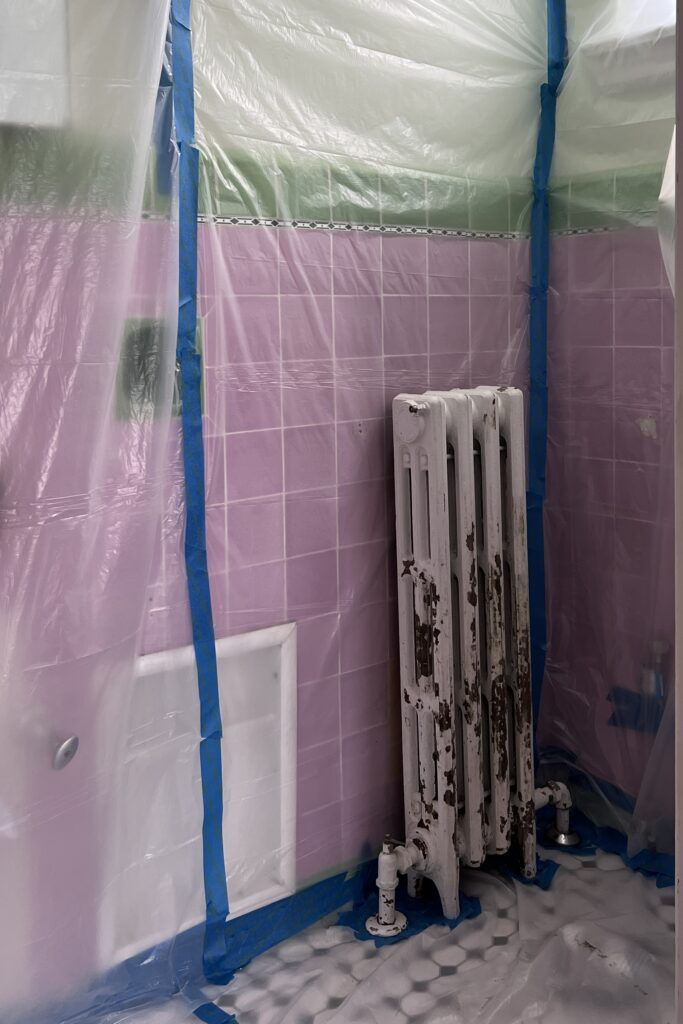
One important thing I wanted to note is that we don’t actually use this radiator. It’s turned off because it’s such a small bathroom that it’s just not necessary. Assuming your radiator is active, be sure to also tape off the control valve or any vents, depending on the type of radiator you have.

Step Four: Prime
For primer, I used Sherwin Williams extreme bond primer. It’s a great quality primer that’s meant to adhere nicely to metal surfaces.
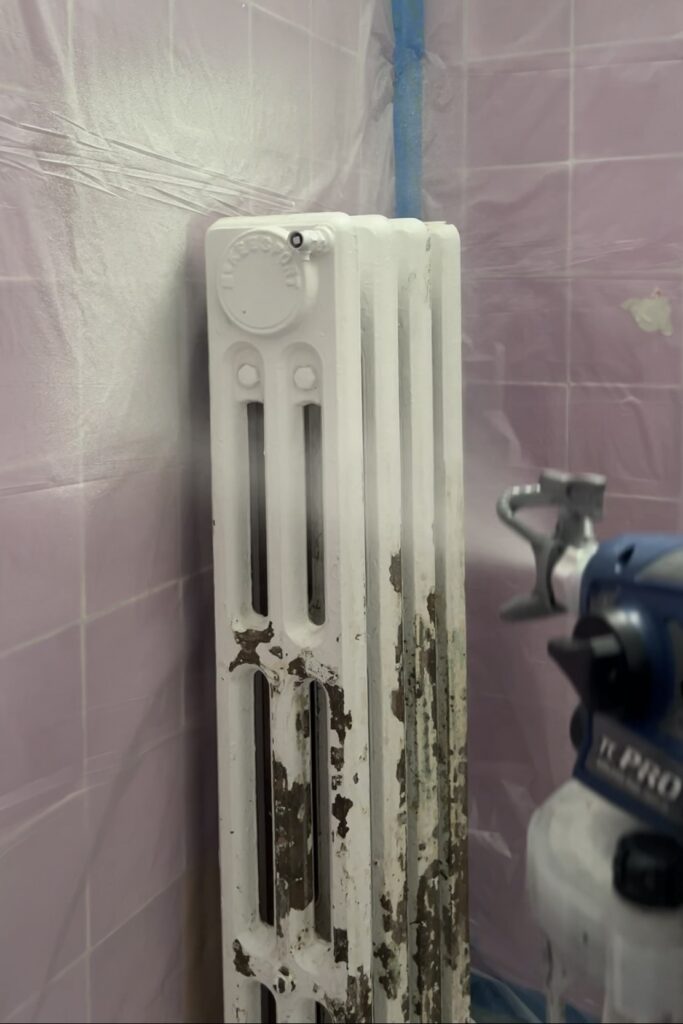
But if you have rust, this primer isn’t going to block it. Ask me how I know 🙂

Do you see all the rust bleeding through? You live and you learn! To fix this, I ended up sanding it down the best I could (after the primer was fully dry) and then I did a second coat using this primer spray. That seemed to solve the issue!!
As I mentioned in step two, if you have a really rusty radiator, try using Ospho followed by an an all surface enamel oil-based primer.
Step Five: Paint
Before we dive into the details on painting, I just wanted to remind you that we don’t use the heat for the radiator I painted in this tutorial. However, I still did a lot of research on the right paint to use. We have several radiators (that we do use) that need a fresh coat of paint so I thought it’d be a good idea to be prepared for that.
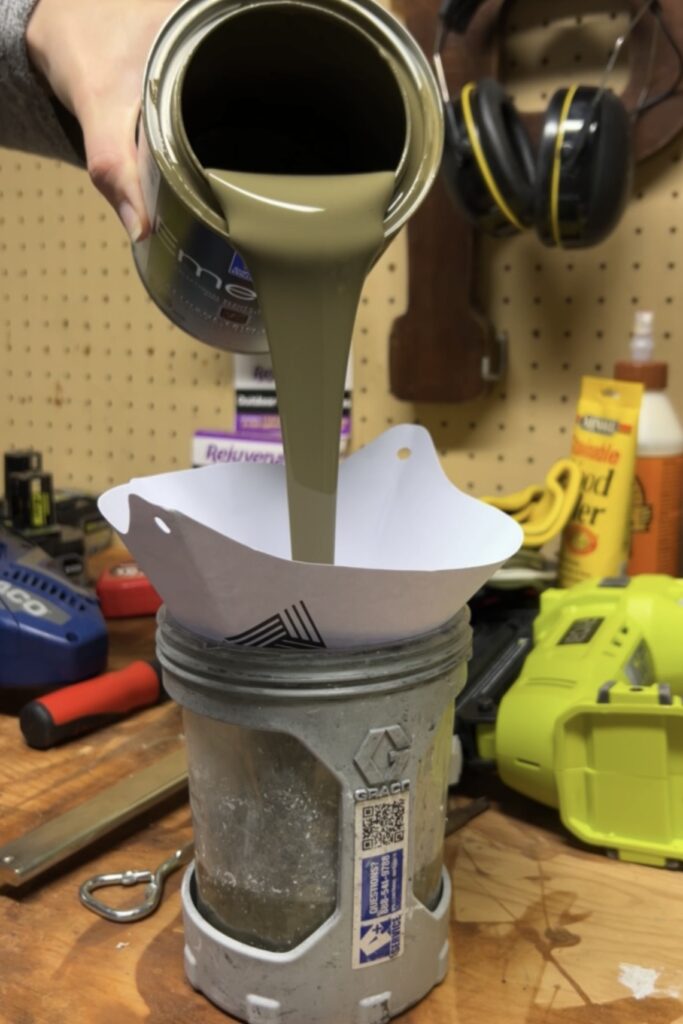
What type of paint do you use on a radiator?
Most tutorials recommend using a heat-resistant paint, but a few others say an enamel paint works just fine since most radiators don’t get to super high temperatures. My thought here is that it’s better to be safe than sorry.
We used an enamel paint, but again, we don’t turn the heat on for this particular radiator. When I paint the other radiators in our house, I would choose one of these products:
- Farrow & Ball Radiator Paint (Modern Eggshell specifically)
- Benjamin Moore Super Spec
- Benjamin Moore INSL-X Spray Paints
- Sherwin Williams Direct-to-Metal Alkyd Enamel
- Ecos Paints Water Based Radiator Paint (Designed specifically for hot water radiators, so this product isn’t suitable for steam radiators or electric storage radiators)
- Krylon High Heat Spray Paint
- Rust-Oleum Oil-Based Enamel Paint
Tips for Painting a Radiator
When it comes to paint application, you have the option to spray or hand paint! Spraying requires more prep time, but the actual painting process is incredibly fast, and it definitely gives the best finish. Hand painting will be much more time consuming, and you might have visible brush strokes, but you don’t have to deal with taping off the entire room. Or cleaning the sprayer 😉
I decided to use my paint sprayer which made the painting process incredibly simple. Here’s a few tips for using a paint sprayer on a radiator:
- Ventilate the room before painting (open a window or use a fan)
- Strain your paint (as you can see in the photo above)
- Thin the paint if necessary (just be sure to look into the specific type of paint you’re using)
- Test out the pressure on a scrap piece of cardboard before trying it on your radiator
- Use smooth, even strokes and keep the sprayer about 10″ away from the radiator to prevent drips
- Change the direction of the sprayer as needed to get all the angles
- Keep a foam roller handy to smooth out any drips before they dry
- For an extra smooth finish, use steel wool or a high grit sandpaper after the first coat of paint
- Apply two to three coats of paint (I only needed to do two!)
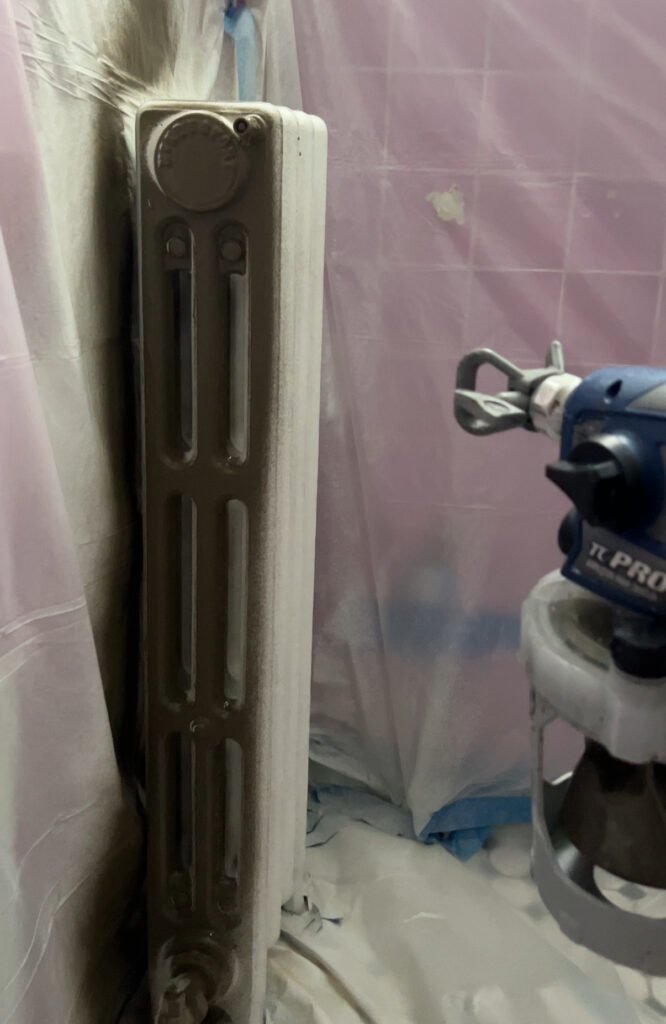
If you decide to hand paint your radiator, I don’t have tips for that yet because I haven’t personally tried it. However, I’d image you’ll need more than just a regular paint brush in order to get in some of the hard to reach areas.
Don’t worry too much about getting to the back of the radiator. I feel like it’s near impossible to cover the entire surface of the radiator. I’m not even sure I was able to fully get that with my paint sprayer, but you can’t even tell!
PS in case you’re curious, this is the color I used!!
Paint Color Ideas for Radiators
Radiators certainly have their pros and cons when it comes to interior design, but I personally think they can add so much character to a space! Here’s a few radiator paint ideas:
- Painting radiators to match walls– This gives a nice, seamless look and is a great way to make a space feel less cluttered and more intentional. (I highly recommend using a Farrow & Ball color since their paint can be use on radiators too!)
- Use radiators for a pop of color– On the contrary, I think it’s so fun to use a bold color (ever heard of the unexpected red theory?!) to add some excitement and personality!
- Black is classic– I mean, you really can’t go wrong with black! This would be really striking in a home with a more modern feel and light colored floors.
- Go dark and moody!– I’m picturing a deep, rich color like burgundy or plum to add some drama to a space because… why not?! Have fun with it!

Painted Radiator Before and After
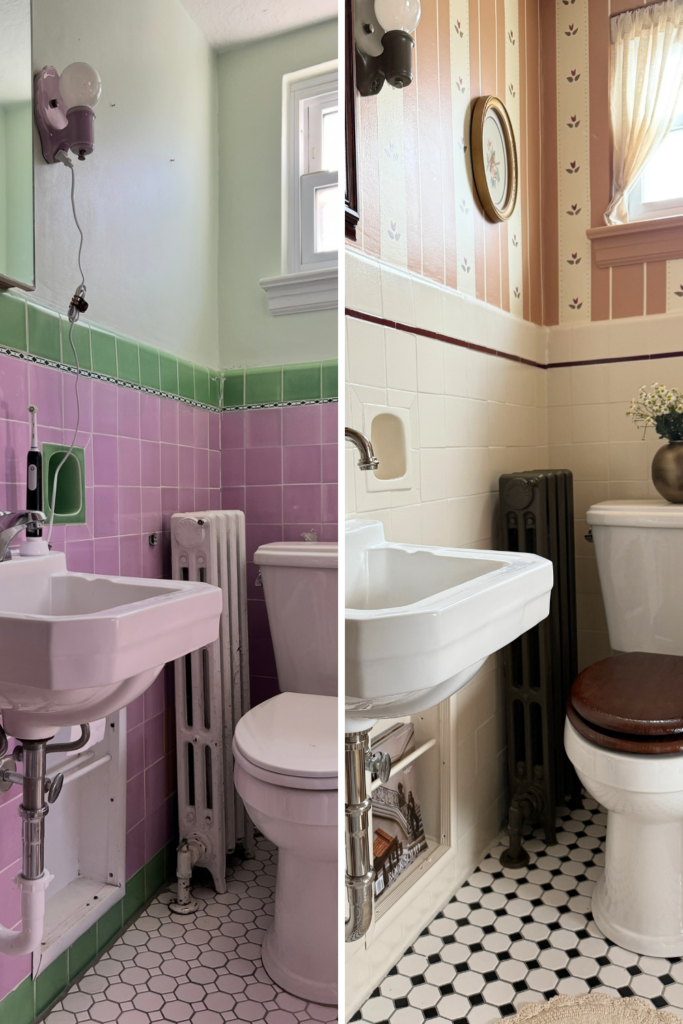
Just a few simple steps made all the difference… I can’t get over it! I’m loving the new color!!

And if you can’t tell, I did a whole bathroom makeover and paint alone completely transformed this bathroom.
Anyway, I hope you learned everything you wanted to know about radiator painting. Please let me know if you have any questions!! As always, thank you for being here 🙂
Elisha